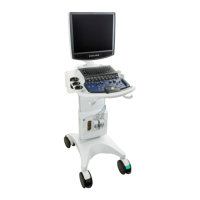17.
Acoustic Output
This section describes acoustic-output-related parameters and considers the relation
between these parameters and user controls on the systems. The display accuracy and
measurements precision of these parameters is also discussed.
Detailed information on acoustical power output for each transducer, in each operating
modality, is in the dedicated table provided in section 17.
Acoustical power output is dependent on both system control settings and the probe
selected.
ALARA Principle
The prudent use of ultrasound requires a constant consideration of the risk-benefit ratio for
the patient, along with employment of the ALARA principle. ALARA stands for as low as
reasonably achievable. ALARA means that the sonographer uses only a much ultrasonic
power for as long as needed to obtain the necessary clinical information. With training,
education, and experience, the sonographer can systematically keep the patient risk for
potential bioeffects of ultrasound to a minimum. ALARA is the guiding principle for the
use of diagnostic ultrasound. Qualified sonographers, using good judgment and insight,
determine the exposure that is as low as reasonably achievable. There are no
rules to
determine the correct response to every situation.
The sonographer keeps exposure low, bioeffects minimal, and images diagnostic. A
thorough knowledge of the imaging modes, probes, system, and scanning techniques for
this system is necessary.
The acoustic output of the ultrasound system has been measured and calculated per the
Acoustic Output Measurement Standard for Acoustic Output Measurement Standard for
Diagnostic Ultrasound Equipment, Revision 3 (NEMA, UD 2) and the Standard for Real-
Time Display of Thermal and Mechanical Acoustic Output Indices on Diagnostic
Ultrasound Equipment, Revision 2 (NEMA UD3).
Applying ALARA
The scanner-imaging mode is selected by the sonographer and is determined by what
information is required, For example, 2D imaging provides anatomical information.
Understanding the nature of the imaging mode being used allows a trained sonographer
to apply the ALARA principle.
With training, education, and experience, the sonographer can systematically keep the
patient risks for potential bioeffects of ultrasound down to a minimum. This means using
ultrasound as an effective and often essential source of diagnostic information and not as
a source of entertainment.
For information about
ALARA and possible bioeffects, refer to the Medical Ultrasound Safety

